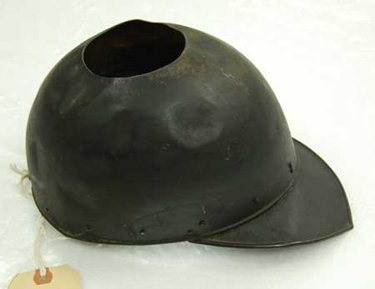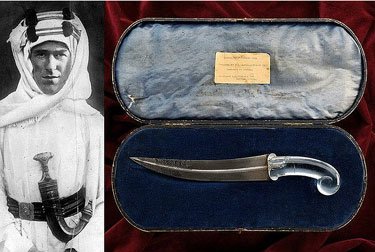Category Archive 'Arms & Armor'
31 Aug 2021

 dav Epoch Times:
A link to Ireland’s medieval past was located in a shed after a chance encounter during Granard’s Heritage Week this summer.
That find consisted of an authentic, stunningly well-preserved 800-year-old chain mail vest—called a hauberk—discovered fully intact.
Bartle D’Arcy, general manager of local heritage center Granard Knights & Conquests, was wearing a replica hauberk mid-August when some locals approached him and said they had one just like it in their shed.
“I was wearing a chainmail coif when some people from the locality in Longford approached me and said they had some of that in their shed, which utterly amazed me,” D’Arcy told The Epoch Times.
“I said ‘what do you mean you have some of that in your shed?’”
Three days later, they brought the vest in, which had been kept in a bucket for two years after it was found by an excavator doing drainage work.
“We thought we had a fragment, but we have the entire hauberk,” he said in a statement published by Longford Leader.
The chainmail vest is believed to date back to 1172 when the Normans arrived in Longford, linking it to Risteárd de Tiúit and construction of the timber-frame castle on the Motte in 1199, said the center’s education officer Déirdre Orme.
“We think it’s related to the Motte because chain mail is expensive,” D’Arcy added.
RTWT
HT: Bird Dog.
24 Oct 2018


The helmet.
————————-

The gorget.
John Gregory Bourke (1846-1896) enlisted in the Fifteenth Pennsylvania Volunteer Cavalry at the age of 16, and was awarded a Medal of Honor for “gallantry in action” at the Battle of Stones River, Tennessee, in December 1862. He also fought at Chickamauga under George H. Thomas.
After the war, through Thomas, he received an appointment to West Point where he graduated in 1869, and was then assigned as a second lieutenant in the Third U.S. Cavalry. He served with his regiment at Fort Craig, New Mexico Territory, from September 29, 1869 to February 19, 1870.
Bourke was an enthusiastic student of Indian ethnology, on which subject he published a number of studies, and a copious diarist.
He compiled, from his diaries, a military memoir, On the Border with Crook, published in 1892, which is one of the key primary sources on the Indian Wars.
His quarters in New Mexico were simple and rough, he tells us, but they were decorated with a set of three hundred year old Spanish armor.
My assignment was to one of the rooms in the adobe house, an apartment some fourteen by nine feet in area, by seven and a half or eight in height. There was not enough furniture to occasion any anxiety in case of fire: nothing but a single cot, one rocking-chair — visitors, when they came, generally sat on the side of the cot — a trunk, a shelf of books, a small pine washstand, over which hung a mirror of greenish hue, sold to me by the post trader with the assurance that was French plate. I found afterward that the trader could not always be relied upon, but I’ll speak of him at another time. There were two window curtains, both of chintz; one concealed the dust and fly specks on the only window, and the other covered the row of pegs upon which hung sabre, forage cap, and uniform.
In that part of Arizona fires were needed only at intervals, and, as a consequence, the fireplaces were of insignificant dimensions, although they were placed, in the American fashion, on the side of the rooms, and not, as among the Mexicans, in the corners. There was one important article of furniture connected with fireplace and which I must make mention—the long iron poker with which, on occasion I was want to stir up the embers, and also to stir up the Mexican boy Esperidion, to whom, in the wilder freaks of my imagination, I was in the habit of alluding as my “valet.â€
The quartermaster had recently received permission to expand “a reasonable amount†of paint upon the officers’ quarters, provided the same could be done by labor of the troops. …
It goes without saying that the work was never any too well done, and in the present case there seemed to be more paint scattered about my room than would have given it another coat. But the floor was of rammed earth and not to be spoiled, and the general effect was certainly in the line of improvement. Colonel Dubois, our commanding officer, at least thought so, and warmly congratulated me on the smug look of everything and added a very acceptable present of a picture—one of Prang’s framed chromos, a view of the Hudson at the mouth of the Esopus creek – which gave a luxurious finish to the whole business. Later on, after I had added an Apache bow and quiver, with its complement of arrows, one or two of the bright, cheery Navajo rugs, a row of bottles filled with select specimens of tarantulas, spiders, scorpions, rattlesnakes and others of the fauna of the country, and hung upon the walls a suit of armor which had belonged to some Spanish foot-soldier of the sixteenth century, there was a sybaritic suggestiveness which made all that has been related of the splendors of Solomon and Sardanapalus seem commonplace.
Of that suit of armor I should like to say a word: it was found by surgeon Steyer, of the army, enclosing the bones of a man, in the arid country between the waters of the Rio Grande and the Pecos, in the extreme southwest corner of the State of Texas, more than 20 years ago. Various conjectures were advanced and all sorts of theories advocated as to its exact age, some people thinking that it belonged originally to Coronado’s expedition, which entered New Mexico in 1541. My personal belief is that belong to the expedition of Don Antonio Espayo or that of Don Juan de Oñate, both of them came to New Mexico about the same date —1581-1592—and travelled down the Concho to its confluence with the Rio Grande, which would have been just on the line where the skeleton in armor was discovered. There is no authentic report to show that Coronado swung so far to the south; his line of operation took in the country farther to the north and east, and there are the best of reasons for believing that he was the first white man to utter the fertile valley of the Platte, not far from Plum Creek, Nebraska.
But, be that as it may, the suit of armor — breast and back plates, gorget, and helmet — nicely painted and varnished, and with every tiny brass button duly cleaned and polished with acid and ashes, added not a little to the looks of the den which without them would’ve been much more dismal.
For such of my readers may not be up on these matters, I may say that iron armor was abandoned very soon after the Conquest, as the Spaniards found heat of these dry regions too great to admit of their wearing anything so heavy; and they also found that like cotton batting “escaupiles†of the Aztec served every purposes as a protection against the arrows of the naked savages by whom they were now surrounded.
—————–
Parts at least of Bourke’s Spanish armor have survived, and I found some discussion on the Internet in a discussion thread at Above Top Secret:
The few records of the armor that exist came from U.S. cavalry officer and anthropologist Capt. John Gregory Bourke, who was given the gorget, helmet, and a breast- and backplate in 1870, from an army doctor who claimed to have found them “enclosing the bones of a man in the arid country between the waters of the Rio Grande and the Pecos.â€
Bourke took the armor with him from post to post throughout the West during his career, losing the breast and backplates to thieves in Arizona along the way.
But before his death in 1896, Bourke gave the helmet and gorget to a judge’s wife in Nebraska, and by the early 20th century, it was in the possession of an Omaha attorney, in whose family it remained until it was donated to a museum in 1961, and then to the state historical society.
The assumption is the armor is Spanish, that would be the most likely scenario as it dates to the appropriate period.
Historical records describe the equipment used by Spanish soldiers at that time, but the team found that it included little armor, the Spanish instead having used mostly padded leather or shirts of chain mail.
“It just is not very much like armor known to have been used by colonial Spanish forces,†Bleed said of Bourke’s armor of iron scales.
“The Spanish apparently had some (chain) mail, but the idea of taking a fabric and attaching little fish scales to it, this is not something they did.â€
It’s too bad the breast plate and back were lost as they would shed more light on where this came from.
RTWT
16 Mar 2016


Czerny’s International Auction House, Sarzana, Italy, Fine & Scarce Antique Arms & Armor Sale, 26 March 2016, Lot 574.
Estimated Price: €7,000 – €8,500
A very interesting rock crystal hilted kandshar from the property of Lawrence of Arabia
dating: mid-19th Century
Curved, double-edged blade with a raiser made of fine, wootz damask at the centre (areas of rust); rock crystal grip (sliver near the quillon).
Kept in a wooden case covered with black, gilt-hemmed paper, lined with light-blue silk and bue velvet, the cover featuring a label with the writing “Jambia/Rock Crystal Hilt – Property of T. E. Lawrence/Clouds Hill – Lawrence of Arabia – Purchased S. W. Cottee & Son Wareham Dorset”.The lieutenant colonel Thomas Edward Lawrence (Tremadog, 16th August 1888 — Wareham, 19th May 1935) was a British intelligence agent, a military officer, archaeologist and writer, mostly known as Lawrence of Arabia; he was renowned for his liaison role during the Arab Revolt at the beginning of XX Century.
Sale: S. W. Cottee & Son (known today as “Cottees”);
Sale: Dix Noonan & Webb, 19/09/03 lot 1024;
Stratford Armouries Museum at Warwick.
Your are browsing
the Archives of Never Yet Melted in the 'Arms & Armor' Category.
/div>

Feeds
|
